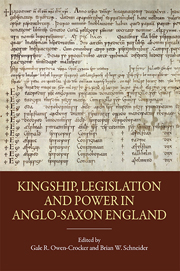Book contents
- Frontmatter
- Contents
- List of Illustrations
- List of Tables
- Contributors
- Preface
- Abbreviations
- Introduction
- PART I
- PART II
- 2 Anglo-Saxon Royal Archives: Their Nature, Extent, Survival and Loss
- 3 Naming and Royal Authority in Anglo-Saxon Law
- 4 Witnessing Kingship: Royal Power and the Legal Subject in the Old English Laws
- 5 The Burial of Kings in Anglo-Saxon England
- 6 Ine 70.1 and Royal Provision in Anglo-Saxon Wessex
- 7 Being Everywhere at Once: Delegation and Royal Authority in Late Anglo-Saxon England
- Index of persons and places
5 - The Burial of Kings in Anglo-Saxon England
from PART II
Published online by Cambridge University Press: 05 December 2013
- Frontmatter
- Contents
- List of Illustrations
- List of Tables
- Contributors
- Preface
- Abbreviations
- Introduction
- PART I
- PART II
- 2 Anglo-Saxon Royal Archives: Their Nature, Extent, Survival and Loss
- 3 Naming and Royal Authority in Anglo-Saxon Law
- 4 Witnessing Kingship: Royal Power and the Legal Subject in the Old English Laws
- 5 The Burial of Kings in Anglo-Saxon England
- 6 Ine 70.1 and Royal Provision in Anglo-Saxon Wessex
- 7 Being Everywhere at Once: Delegation and Royal Authority in Late Anglo-Saxon England
- Index of persons and places
Summary
We have a complete record of the places of burial of the kings of Wessex and England from the reign of Æthelwulf (839–58) onwards (Table 5.1). For the earlier historic period the sequences are incomplete (Table 5.2), but we are still more likely to know where a king was buried than where he was born or married. Though most of the tombs themselves and their contents have been lost, some have been recovered through excavation and some written accounts give very precise details about the location of a king's burial, as will become apparent in the discussion below. There is therefore a valuable body of evidence surviving for one of the major rites of passage which all kings had to undergo. The problems in interpreting the evidence, of course, should not be underestimated as there is much we are never told. Who made the final decision about a king's resting-place? Sometimes, for instance, when the place of burial was a church which had enjoyed much patronage from the ruler during his lifetime, it may be safe to conclude that the choice was his, but this is unlikely to have always been the case, as evidence from later periods suggests. Nor did royal bodies necessarily remain where they were originally interred. Relatives might remove them to what was considered a more appropriate place, or rivals oust them altogether. Those kings who were also saints were particularly likely to have had their bodies translated from their original places of burial.
- Type
- Chapter
- Information
- Kingship, Legislation and Power in Anglo-Saxon England , pp. 237 - 258Publisher: Boydell & BrewerPrint publication year: 2013



